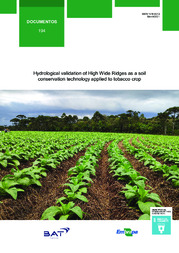Hydrological validation of High Wide Ridges as a soil conservation technology applied to tobacco crop.
Hydrological validation of High Wide Ridges as a soil conservation technology applied to tobacco crop.
Author(s): DENARDIN, J. E.; MARCON, G. P.; FAGANELLO, A.; LEMAINSKI, J.; BACK, A. J.; JUNQUEIRA, B. R.; OLIVEIRA, V. B. de
Summary: High Wide Ridge Soil Management is a conservation practice associated with the no-tillage, reduced tillage, and conventional tillage systems, usual in small farms in southern Brazil. Integrated with winter grain or ground cover crops such as wheat (Triticum aestivum), rye (Secale cereale), black oats (Avena strigosa) and white oats (Avena sativa), millet (Pennisetum glaucum L.), Sudan grass (Sorghum sudanense), sorghum (Sorghum spp.), mucuna (Mucuna spp.), and brachiaria (Brachiaria spp.), high wide ridge is being used for tobacco (Nicotiana tabacum), soybean (Glycine max L.), maize (Zea mays), and beans (Phaseolus vulgaris) during the spring and summer seasons. The benefits expected from this technology, related to the performance of the tobacco crop, have already been proven experimentally and on a farm scale. However, the benefit in regard to the effectiveness in controlling runoff resulting from intense rainfall, has not yet been quantified. The aim of this study was to validate the effectiveness of the high wide ridge in containing runoff from intense rainfall, with return periods equal to, or greater than, 10 years. The study was carried out on 11 farms, located in nine municipalities (four in Rio Grande do Sul state, three in Santa Catarina state, and four in Paraná state), where tobacco was grown following winter cereal as a ground cover crop, on three types of topography (gently undulating topography, undulating topography, and highly undulating topography) with 11 soil types that were texturally and taxonomically different. It was concluded that high wide ridge is capable of containing the flooding generated by rainfall with return periods of more than 10 years, allowing the science of soil conservation to promote it as a conservation soil management practice.
Publication year: 2021
Types of publication: Booklets
Unit: Embrapa Wheat
Observation
Some of Embrapa's publications are published as ePub files. To read them, use or download one of the following free software options to your computer or mobile device. Android: Google Play Books; IOS: iBooks; Windows and Linux: Calibre.
Access other publications
Access the Agricultural Research Database (BDPA) to consult Embrapa's full library collection and records.
Visit Embrapa Bookstore to purchase books and other publications sold by Embrapa.

